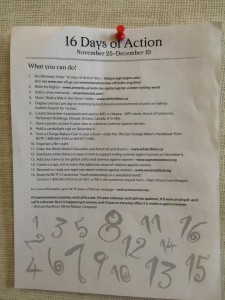It’s been a great new year. The beginning of the term has provided me with a wealth of practical knowledge and resources that I’ve been weaving into my lessons. I’ve even noticed some resources at my practicum school that are helping teachers bring the ‘act’ portion of the IB action cycle into their lessons. The picture I’ve attached is a notice I found in the staff room, highlighting 16 activities teachers can bring into their classes every day. It’s been great to observe and be a part of a school community where action is being taken, and as I continue to look for action, I notice a number of examples every day. Here are a few:
- The crosswalk kids: Every morning students go outside with ‘official’ red jackets to ensure that cars are following the speed limit
- Organizing Jump Rope for Heart day: Before school, teachers collaborate ideas on dates and locations that will allow the activity to run smoothly
- Salmon spawning: Some students have expressed their interests in the salmon cycle, so a couple faculty members have brought in a fish tank and they are spawning salmon on school grounds
- Big buddies: Older students are working with younger ones during recess and lunch hour to provide company and support if any problems or questions arise.
The list of action-based activities goes on, and each of these activities works toward empowering the students. I’ve talked to many of the students regarding their choice of action, and it’s clear that they’ve formulated strong opinions and are confident in their learning directions. It’s been inspiring and informative to see the effects of ‘act’ within the action cycle. I’ll be keeping my eyes open to see if I can spot students in the ‘reflect’ portion of their work.
Thanks,
Chris


Chris,
I love this 16 Days of Action! I love class challenges like this where we can encourage our students and get them excited! Not only is it fun and engaging but things like the Crosswalk Kids is so educational for students and it is a real-life experience in which they probably will always remember doing.
This reminds me of when we were asked to think back and remember something from when we had Aha moments of when we were young, and most of us experienced this on a field trip or “taking action” in something.
I am happy to see that this has inspired you. Have you thought about doing an action piece with your class??
Have a great weekend Chris and thanks for sharing this!
Tobi Watt
Hi Chris,
I like how the 16 Days of Action gets students aware of larger issues such as violence against women, and it suggests their involvement in a political aspect (by writing to MPs in Ottawa), but I mostly appreciate how the Action you see is on a smaller, every day scale. I think it is a common misconception by many that Action has to be a large, grandiose venture, when really it can present itself in everyday happenings. Action can be as small as going out of your way to open a door for someone, or saying something kind. It doesn’t always need to be a big, acknowledged event such as a clothing drive or beach clean up. Especially with younger grades, I think it is beneficial to start small for them to understand that their actions have meaning. From there, they can move on to larger issues, but still keep those smaller actions in mind.
Thanks for sharing!
Sydney
This is great to hear, Chris. Sienna also wrote about her Gr. 2’s taking action by cleaning up the playground. How does your SA approach this key IB area? What are the Gr. 5’s doing to connect their learning to real life? I imagine they could come up with some great ideas related to their inquiry into the different body systems! I like how you are thinking about the reflect piece too. This is an important part of the Action Cycle.